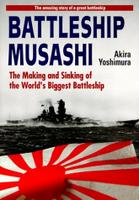 Battleship Musashi
Battleship MusashiI read this book a couple of weeks ago. It is a light narrative on the building and subsequently, the short operational career of this white elephant. The perspective is indeed different as Akira Yoshimura is a Japanese popular historian of sorts.
You won't find any book reviews in my blog, it takes too much energy to write a good proper one. I will, instead, make a few observations (like in my other blog entries concerning books).
Firstly, during the building of the capital ship, secret police from the civil government were utilised in both arresting ethnic Chinese people and other foreigners living in Nagasaki. Not surprisingly, there was a focus on the Chinese during the arrests and deportations. Military personnel were used in civil roles such as securing the hills beyond the perimeters of the shipyard. A lack of reaction from the populace appeared to point to a quiet acceptance of the erosion of civil rights and the rise of miltiarism during that period. The co-operation of the civil and military in these operations were an indication of the level of ultra-nationalism and militarism which permeated the Japanese society in the years leading to the war. The exercise of funds to purchase warehouses and buildings near the docks to prevent foreigners from observing the construction was another indication.
Secondly, the Nagasaki Shipyard, owned by Mitsubishi Heavy Industries, was previously constructing the battleship Tosa and battlecruiser Takao before work was halted. Like the Kure shipyard which built the Yamato, this shipyard was capable of launching the largest of battleships. In the course of building the Mushashi, many new measures were undertaken and this had strained the resources of the yard to the utmost. As noted in many studies, the Japanese navy would have been better served by building more escort vessels rather than this battle wagon. Thus, during a crucial period leading to Japan's eventual defeat, the shipyard was tied up constructing a white elephant.
Thirdly, there was a mention of the warship utilising its main guns in an anti-aircraft role where the skies were cleared of American aircraft using a special shotgun type scatter shell. The claim of a single salvo wiping out a formation of aircraft appeared to be extremely unlikely.
Despite the vast numbers of anti-aircraft artillery mounted (though mostly of the 25mm variety), the Musashi appeared to have shot down very few of its attackers.
The attitudes of the crew and the shipbuilders were that the battleship was 'unsinkable' despite the loss of other major surface ships of the British, American and Japanese. The sense of a created reality due to ultra-nationalism was clearly evident here where it was thought that the martial spirit would overcome anything.
The Musashi also spent most of its life in port due to a lack of oil and also of a role.
Lastly, the book made scant mention of the causes of the war beyond that of the United States imposing trade sanctions and freezing Japanese assets. There was no mention of the war on China and the US demand for withdrawal as a pre-condition to withdrawing sanctions. There was no mention of the sneak attack on Pearl Harbour. The implication is that the United States had forced Japan's hand.
"give me your faith,
something i can believe in
and you'll be my family,
my brother, my friend tell me a truth
that i find not deceiving
teach me a lesson that i understand"
'Exterminate, annihilate, destroy' Rotersand
2 comments:
The Yamato and Musashi appears to be a decision made in defiance to the Washington Treaty, and executed many years too late.
I just don't understand why didn't they concentrate on building a few more aircraft carriers. They should have converted them like they did the Shinano. But then again, it's a good thing they made the wrong decisions and help everyone else win the war against them. Hahaha.. :D
Okay, this is off the top of my head.
It's probably the London Treaty of 1930. They denounced it sometime in the middle of the 1930s. (Washington Treaty was in 1920 with a period of a decade.)
The Japanese were consistently cheating with the construction of cruisers and other ships. Their 8000-ton cruisers were claimed to make 36-knots and armed with no less than fifteen 6-inch guns. It was, of course an impossibility as the cruiser was really 12 000 tons and had to be stablised (top-heavy, unstable in heavy seas) with an addition 3000 tons. The resultant cruiser was almost 15000 tons eventually?
When they renounced the treaty, they had many half-completed designs that exceeded the treaty limits. A bunch of liars and cheaters. Absolutely no honour at all.
Those cruisers were an impossibility, of course, and naval authorities of that period should have realised that.
Regarding carriers, they did have many converted carriers. And they did have a surplus of carriers at the end of the war. There were empty carriers at the Battle of Philippine Sea and Leyte Gulf. And some carriers were sunk in harbours in Japan in 1945. They did have almost ten thousand aircraft in 1945. Some of the aircraft were advanced types like the Ki-100, Ki-84 (army types). What they lacked was trained naval air personnel. (and you could say that for trained army air personnel too..)
Post a Comment